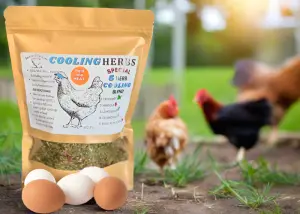
Marek’s Disease is caused by a highly transmissible, deadly chicken herpes virus. Unfortunately, there is no cure for it, but it is 100% preventable. Chicken owners need to be aware of the signs so they can be ready to take action against it. This article will show you how to know if your chicken has Marek’s Disease as well as show you how you can prevent it.
Caring for a chick with Marek’s Disease can be absolutely heartbreaking and very difficult to do. Fortunately, there are steps you can take to prevent if from infecting your backyard chickens in the first place.
What is Marek’s Disease?
Marek’s is a herpes virus that mostly occurs in young, unvaccinated chicks. The virus attacks the brain, spinal cord and nerves, causing inflammation and in some cases tumors. The inflammation and tumors put pressure on the nerves causing paralysis in a chicken’s legs, wings and neck.
Marek’s is most common in chicks around 8-30 weeks of age. Sometimes chicks as young as 3-4 weeks and as old as 40 weeks can get it. One of the most common first signs of Marek’s is paralysis of one or both of a chicken’s legs.

How Does a Chicken Get Marek’s Disease?
A chicken can become infected with Marek’s Disease by inhaling the feather dander or dust particles that have been shed from an infected chicken. Both vaccinated chickens and humans can also carry the infected dander particles and spread this to other chickens.
Infected chickens must be quarantined. It is important not to handle a chicken with Marek’s Disease and then handle a non infected flock member. This disease can hitch hike onto boots, rakes, shovels, hair and clothing infect healthy chickens.
It is recommended to thoroughly shower and to sanitize all clothes and tools after handling or going into a coop of an infected chicken. This will help stop the transmission of dander particles to other chickens.
Once a chicken is infected with this disease, it is infected for life. This does not mean that it will show signs, but it will always “shed” the virus, putting other flock members at risk.
This is why both commercial hatcheries and backyard chicken owners will frequently cull their whole flock when Marek’s has been introduced to the flock.
How Long Does Marek’s Disease Live?
If the conditions are just right, Marek’s can survive up to 65 weeks on chicken coop walls, in nesting boxes, rakes, shovels and boots. Shockingly, it can live for years in chicken coop soil!
Symptoms of Marek’s Disease
| SIGNS AND SYMPTOMS OF MAREK’S DISEASE |
|---|
| 1. PARALYSIS OF ONE OR BOTH LEGS |
| 2. PARALYSIS OF ONE OR BOTH WINGS |
| 3. PARALYSIS OF NECK |
| 4. PALE COMBS & WATTLES |
| 5. WEIGHT LOSS |
| 6. EMACIATION |
| 7. TUMORS IN NERVES, SPINAL COLUMN AND BRAIN |
| 8. BLINDNESS |
| 9. ENLARGED FEATHER FOLLICLES |
| 10. HEAD TREMORS |
| 11. DIFFICULTY BREATHING |
| 12. DIARRHEA |
| 13. SUDDEN DEATH |
| 14. DECREASED GROWTH |
| 15. DECREASED EGG PRODUCTION |
Is Marek’s Disease Contagious to Other Chickens?
- Marek’s Disease is extremely contagious to other chickens so it is important to know the signs and quarantine infected chickens ASAP.
- Non vaccinated chickens can catch Marek’s Disease not only from other infected chickens, but also from infected soil, tools, boots, clothes and by you handling them after being around an infected chicken.
- Not all chickens exposed to Marek’s will become sick. This means that a chicken can become a carrier of the disease and spread it to other chickens, but not show any symptoms itself.
- 10-50% of infected chickens will become ill.
- 90%+ of chickens that are showing symptoms will die within a matter of days to weeks.
Can Humans Get Marek’s Disease from Chickens?
Humans cannot get Marek’s Disease from chickens. However, humans can pass the disease to other chickens. This can happen by transmitting infected feather dander or dust to chickens that are unvaccinated.
| HOW HUMANS SPREAD MAREK’S DISEASE TO CHICKENS |
|---|
| HANDS: HOLDING AN INFECTED CHICKEN AND THEN A NON-INFECTED CHICKEN WITHOUT WASHING |
| SKIN |
| CLOTHES |
| BOOTS |
| TOOLS: RAKES/SHOVELS |
| HAIR |
How Quickly Does Marek’s Disease Spread?
Marek’s Disease can spread rapidly throughout a flock. It is spread just by your chickens inhaling infected dander. An entire flock can contract the disease, but not show any physical symptoms. Infected chickens that don’t show any symptoms can still shed the virus and pass it on to other coop mates.
How Long Will a Chicken Live With Marek’s? A chicken can live with Marek’s Disease, not showing any symptoms and live a full life. Once a chicken begins showing symptoms, it will usually die within a matter of days to weeks.
Some forms of this virus are more virulent than others. It can remain dormant and a chicken may not become ill or you may just have a chicken suddenly die.
How to Prevent Marek’s Disease in Chickens

1. Vaccination of Day Old Chicks Against Marek’s Disease
The number one way to prevent chickens from developing Marek’s Disease if by vaccinating them when they are a day old. Give the vaccine up to one week to do its job, making antibodies. It is important not to expose vaccinated chicks to other chickens during this time.
One week after being vaccinated for Marek’s a baby chick is protected against contracting the deadly virus. Keep in mind, it can still carry dander from an infected chicken and pass it to other coop mates. This is why it is important not to let your flock mingle with other chickens that are not your own.
“Although no treatment is available, current vaccines are highly protective.”
Merck Manual Veterinary Manual
2. Quarantine Chickens With Marek’s Disease
If you suspect that one of your chickens has Marek’s Disease, quarantine it immediately and take the appropriate precautions to stop it from spreading to the other chickens.
Once one of your flock contracts the disease, it is highly likely that the rest of the flock has already been exposed. Anywhere from 10-50% of these chickens will eventually become ill and of those that become ill almost all of them will die.
Many choose to euthanize the whole flock when Marek’s enters their coop.
Marek’s can live in the soil for years. It can live on tools, boots, coop walls, etc. for months. The entire chicken coop, including the soil must be sanitized.
3. Thoroughly Sanitize Chicken Coop and Run
It is important to thoroughly clean your chicken coop and run as well as any equipment that is used in the chicken coop. Marek’s Disease is resistant to some disinfectants, so make sure you find one that will kill it.
How to Clean a Chicken Coop Infected with Marek’s
- Wear protective clothing while cleaning your chicken coop. This includes a mask, goggles, gloves, boots, long sleeves and long pants.
- Remove all bedding material.
- Remove all feeders and watering containers.
- Mix Apple Cider Vinegar and water at a 1:1 ratio. Saturate the walls, perches and floors with this solution. Make sure you get under the roosting bars and in all the corners of the coop. This will help to loosen up the dried chicken poop and also to begin the sanitation process.
- After 15 minutes, the chicken poop should be soft enough to scrub off. Use a scrub brush to brush away any dirt, debris and chicken poop. Scrub the walls, roosting bars, window sills, ceiling and floor.
- Thoroughly spray down the entire chicken coop with water to wash away all of the residual poop and debris that you loosened with scrubbing.
- Use a wet/dry vac to suck up all the remaining poop and debris from the coop floor.
- DISINFECTING SPRAY: After you have thoroughly cleaned the coop, it’s time to disinfect it. This can be done by using Virkon S or bleach. Spray this on the entire coop, including the soil. Follow the manufacturers instructions when using these.
- Use Virkon S or bleach to also clean your chicken feeders, watering containers, your boots and any equipment.
- If you want to use something more natural, you can use apple cider vinegar and water solution. Mix it at a ration of 1:1. Spray everything down thoroughly. This can be done 1 time a week for 6 weeks to help kill the disease.
- Leave windows and doors open and allow the coop to completely dry before bringing new chickens inside.
4. Don’t Add New Chickens to Existing Flock Exposed to Marek’s
Chickens that are carriers of Marek’s, but don’t show symptoms, can still pass this disease to other chickens. This is why you shouldn’t add new chickens to an existing flock exposed to Marek’s.
If one chicken in your flock has died of Marek’s Disease, it is highly likely that the remaining chickens are carriers, but just not showing any symptoms. Remember, only 10-50% of chickens that are carriers will exhibit symptoms.
Many flock owners will cull the remaining chickens to stop the spread of this terrible disease.
5. Quarantine New Chickens Before Combining Two Flocks
Quarantining new chickens before combining two flocks is great practice to decrease the likelihood of introducing any diseases into your existing flock, including Marek’s Disease.
It is recommended to quarantine your new chickens in a separate enclosure, away from your existing flock, for at least 30 days. Just because your new chickens look healthy doesn’t mean they don’t have a hidden disease.
Many times the stress of a move from one place to another can trigger any hidden diseases to become evident.
This gives you the opportunity to observe the new chickens for signs of ill health.
How to Quarantine New Chickens
- Separate your two flocks in entirely different areas for a minimum of 30 days, preferably up to 60 days. This is to also stop the spread of airborne diseases.
- Don’t share feeders, waterers or even cleaning equipment between the two flocks.
- Sanitize shoes and change clothes before walking between the two enclosures.
- Check for parasites such as mites and lice and treat accordingly.
- If the chickens are old enough, look at their combs and wattles. You can tell a lot about a chickens health by looking at its comb and wattle. You can read my article below for some great tips on this.
- Watch for any discharge coming from the eyes, nose or beak.
- Observe chicken poop. It shouldn’t be too runny(diarrhea), have blood or worms in it.
- Watch to make sure that all of the birds are eating and drinking well.
- If after a minimum of 30 days have passed and your new flock is healthy, you can start to integrate them with the existing flock. Don’t just throw them all together. For the safety of your chickens, there is a proper way of integrating two flocks together. You can read my article below for some helpful tips.
CONCLUSION: How to Know if Your Chicken Has Marek’s Disease (+5 Best Prevention Tips)
Marek’s is a terrible disease to watch one of your chickens go through. It may not be treatable, but it is 100% preventable. There are things that you can do to prevent it from showing up in your backyard flock.
- Vaccinate your chicks.
- Quarantine any chickens suspected of Marek’s.
- Routinely sanitize the entire chicken coop, run and equipment.
- Don’t add new chickens into a flock that was exposed to Marek’s.
- Quarantine any new chickens for a minimum of 30 days before adding them to your existing flock.








